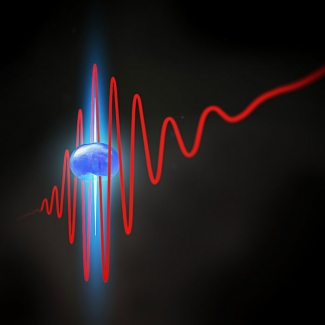Mid-infrared (mid-IR) laser light is accomplishing some remarkable things at JILA. This relatively long-wavelength light (2–4 µm), when used to drive a process called high-harmonic generation, can produce bright beams of soft x-rays with all their punch packed into isolated ultrashort bursts. And, all this takes place in a tabletop-size apparatus. The soft x-rays bursts have pulse durations measured in tens to hundreds of attoseconds (10-18 s).
Until now, attosecond pulses were limited to the extreme ultraviolet (XUV) region of the spectrum. However, these XUV attosecond pulses don’t penetrate most materials, liquids, and complex molecular systems. In contrast, soft x-ray attosecond pulses can penetrate many materials and liquids. Hence they promise to expand the field of attosecond science. Because attosecond soft x-ray bursts can now be readily made in a research laboratory, they will open the door to observing the intricate dance of electrons inside atoms, molecules, liquids, and materials.
A report of the generation of the first attosecond soft x-ray bursts appeared online in theProceedings of the National Academy of Sciences, USA, May 21, 2014. The international team of researchers responsible for this feat included Ming-Chang Chen (National Tsing Hua University), graduate students Chris Mancuso, Ben Galloway, and Dimitar Popmintchev, research associates Carlos Hernández-Garcia and Franklin Dollar, as well as Pei-Chi Huang (National Tsing Hua University), Barry Walker (University of Delaware), Luis Plaja (Universidad de Salamanca), Fellows Andreas Becker, Margaret Murnane, and Henry Kapteyn, and senior research associates Agnieszka Jaron-Becker and Tenio Popmintchev.
Theorists and experimentalists working together hand in hand were able to learn to create bursts of attosecond soft x-rays via high harmonic generation, which has been used extensively and effectively by the Kapteyn/Murnane group. In high harmonic generation, x-rays are produced when electrons are first plucked from argon atoms by a mid-IR laser and then smashed back into their parent ions when the oscillating field of the laser reverses (like the motion of a boomerang). The atoms then naturally emit their excess energy as isolated bursts of soft x-rays. (These harmonics of laser light are like the audible overtones that you can hear when a piano key or guitar string is struck hard.)
The fact that the high harmonics emerged as isolated attosecond bursts of soft x-rays was a beautiful confirmation of theory work that suggested that making attosecond pulses in the soft x-ray region might be possible. But, until the experimental physicists could actually measure the pulses, this theory could not be tested. However, measuring these pulses was no small feat. First, the attosecond pulse had to be split into two parts. Then a special beam separator had to delay part of the pulse (by a distance of just .5 nm) so the two parts could interfere with each other, creating a short burst of soft x-ray light.—Julie Phillips




